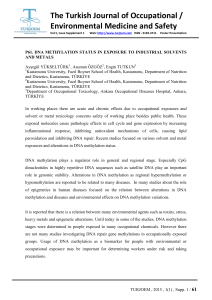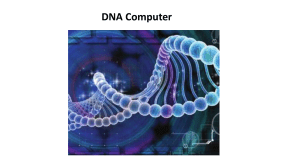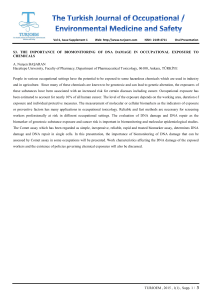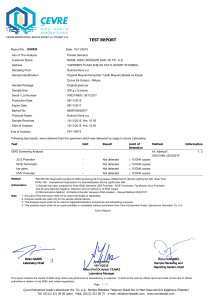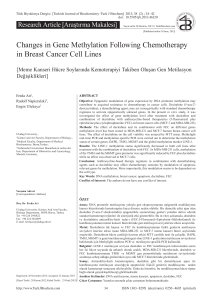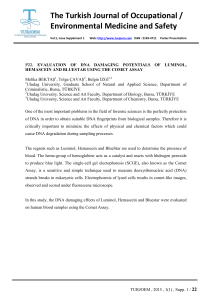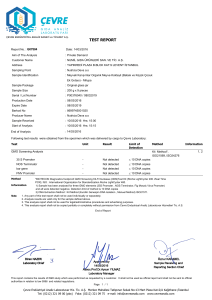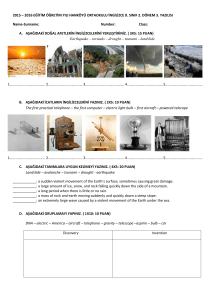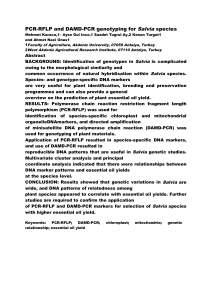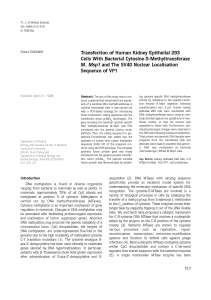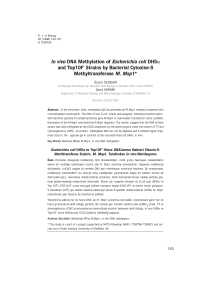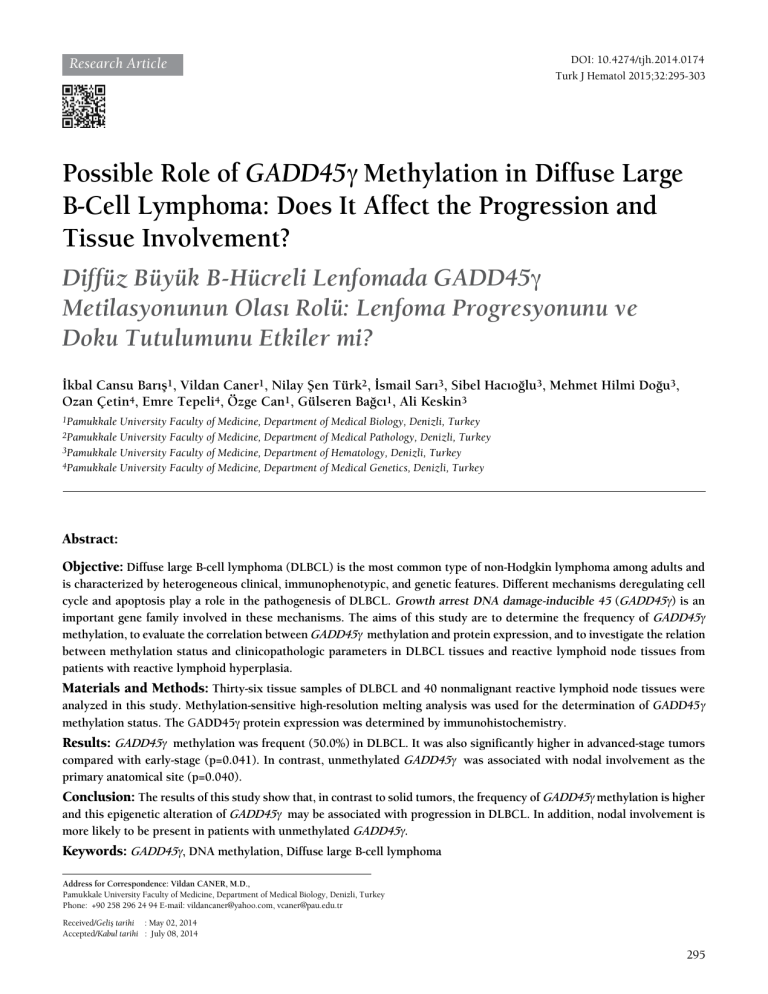
Research Article
DOI: 10.4274/tjh.2014.0174
Turk J Hematol 2015;32:295-303
Possible Role of GADD45γ Methylation in Diffuse Large
B-Cell Lymphoma: Does It Affect the Progression and
Tissue Involvement?
Diffüz Büyük B-Hücreli Lenfomada GADD45γ
Metilasyonunun Olası Rolü: Lenfoma Progresyonunu ve
Doku Tutulumunu Etkiler mi?
İkbal Cansu Barış1, Vildan Caner1, Nilay Şen Türk2, İsmail Sarı3, Sibel Hacıoğlu3, Mehmet Hilmi Doğu3,
Ozan Çetin4, Emre Tepeli4, Özge Can1, Gülseren Bağcı1, Ali Keskin3
1Pamukkale
University Faculty of Medicine, Department of Medical Biology, Denizli, Turkey
University Faculty of Medicine, Department of Medical Pathology, Denizli, Turkey
3Pamukkale University Faculty of Medicine, Department of Hematology, Denizli, Turkey
4Pamukkale University Faculty of Medicine, Department of Medical Genetics, Denizli, Turkey
2Pamukkale
Abstract:
Objective: Diffuse large B-cell lymphoma (DLBCL) is the most common type of non-Hodgkin lymphoma among adults and
is characterized by heterogeneous clinical, immunophenotypic, and genetic features. Different mechanisms deregulating cell
cycle and apoptosis play a role in the pathogenesis of DLBCL. Growth arrest DNA damage-inducible 45 (GADD45γ) is an
important gene family involved in these mechanisms. The aims of this study are to determine the frequency of GADD45γ
methylation, to evaluate the correlation between GADD45γ methylation and protein expression, and to investigate the relation
between methylation status and clinicopathologic parameters in DLBCL tissues and reactive lymphoid node tissues from
patients with reactive lymphoid hyperplasia.
Materials and Methods: Thirty-six tissue samples of DLBCL and 40 nonmalignant reactive lymphoid node tissues were
analyzed in this study. Methylation-sensitive high-resolution melting analysis was used for the determination of GADD45γ
methylation status. The GADD45γ protein expression was determined by immunohistochemistry.
Results: GADD45γ methylation was frequent (50.0%) in DLBCL. It was also significantly higher in advanced-stage tumors
compared with early-stage (p=0.041). In contrast, unmethylated GADD45γ was associated with nodal involvement as the
primary anatomical site (p=0.040).
Conclusion: The results of this study show that, in contrast to solid tumors, the frequency of GADD45γ methylation is higher
and this epigenetic alteration of GADD45γ may be associated with progression in DLBCL. In addition, nodal involvement is
more likely to be present in patients with unmethylated GADD45γ.
Keywords: GADD45γ, DNA methylation, Diffuse large B-cell lymphoma
Address for Correspondence: Vildan CANER, M.D.,
Pamukkale University Faculty of Medicine, Department of Medical Biology, Denizli, Turkey
Phone: +90 258 296 24 94 E-mail: [email protected], [email protected]
Received/Geliş tarihi : May 02, 2014
Accepted/Kabul tarihi : July 08, 2014
295
Turk J Hematol 2015;32:295-303
Barış Cİ, et al: GADD45γ Methylation in Diffuse Large B-Cell Lymphoma
Öz:
Amaç: Diffüz büyük B-hücreli lenfoma (DBBHL) yetişkin bireylerde Hodgkin-dışı lenfomaların en yaygın tipidir ve klinik,
immünofenotipik ve genetik özellikler açısından heterojen özellikler taşıması ile karakterizedir. DBBHL patogenezinde hücre
döngüsü ve apoptoz regülasyonunu bozan farklı mekanizmalar rol oynamaktadır. Growth arrest DNA damage-inducible 45
(GADD45γ), bu mekanizmalarda yer alan önemli bir gen ailesidir. Bu çalışmanın amaçları DBBHL doku örnekleri ve reaktif lenfoid
hiperplazili bireylerin reaktif lenfoid doku örneklerinde GADD45γ metilasyon sıklığını belirlemek, GADD45γ metilasyonu
ile protein ekspresyonu arasındaki ilişkiyi değerlendirmek ve DBBHL olgularında metilasyon durumunun klinikopatolojik
parametrelerle ilişkisini araştırmaktır.
Gereç ve Yöntemler: Bu çalışmada 36 adet DBBHL doku örnekleri ve 40 adet malign-olmayan reaktif lenfoid doku örnekleri
analiz edildi. GADD45γ metilasyon durumunu belirlemek için metilasyona-duyarlı yüksek çözünürlüklü erime eğrisi analizi
kullanıldı. GADD45γ protein ekspresyonu immünohistokimyasal analiz ile belirlendi.
Bulgular: DBBHL’de GADD45γ metilasyonunun sık olduğu belirlendi (%50). Aynı zamanda, erken evre ile karşılaştırıldığında
ileri evre tümörlerde GADD45γ metilasyonu istatistiksel olarak anlamlı düzeyde yüksekti (p=0,041). Ancak, GADD45γ metilasyon
yokluğunun primer anatomik yerleşim olarak nodal tutulumla ilişkili olduğu belirlendi (p=0,040).
Sonuç: Bu çalışmanın sonuçları solid tümörlerin aksine, DBBHL’de GADD45γ metilasyon sıklığının yüksek olduğunu ve
GADD45γ geninde gözlenen bu epigenetik değişimin, hastalığın progresyonu ile ilişkili olabileceğini göstermektedir. Buna ek
olarak, nodal tutulum daha çok GADD45γ metile olmayan olgularda gözlenmektedir.
Anahtar Sözcükler: GADD45γ, DNA metilasyonu, Diffüz büyük B-hücreli lenfoma
Introduction
Diffuse large B-cell lymphoma (DLBCL) is the most
common group of non-Hodgkin lymphomas (NHLs) and
represents 30% to 40% of all newly diagnosed NHLs in Western
countries. DLBCL represents a heterogeneous group of
neoplasms with diversity in clinical presentation, morphology,
and genetic and molecular properties [1]. It is well known
that genetic and epigenetic changes that create a difference
in gene expression profiles between normal and malign B
cells are responsible for the heterogeneity of DLBCL. Genetic
aberrations in DLBCL are chromosomal translocations,
aberrant somatic hypermutations, and copy number variations
including amplifications or deletions [2,3,4,5]. Other
differences come from epigenetic modifications such as DNA
methylation [6,7,8].
DNA methylation may lead to transcriptional silencing by
at least 3 different mechanisms: inhibition of binding of the
transcription factors to their specific sequences, a direct effect
on nucleosome positioning, and recruitment of other nuclear
factors that recognize the methylated CpG dinucleotide
blocks binding other factors including transcription factors
[9]. To date, a number of genes involved in the regulation
of DNA repair, cell cycle control, and apoptosis, such as
MGMT [10,11], DAPK1 [12], and GADD45γ [13], have been
determined as hypermethylated in DLBCL. A recent study
also showed that abnormal methylation patterns might be
seen depending on chromosomal regions, gene density, and
296
methylation status of neighboring genes in normal B-cell
populations and NHL [8].
The growth arrest DNA damage-inducible (GADD45) gene
family plays important roles in various cell functions such
as DNA repair, cell-cycle control, and cell growth [14]. The
members of the GADD45 gene family, GADD45γ, GADD45γ,
and GADD45γ, are evolutionarily conserved and expressed
in both fetal and adult tissues [15,16,17]. They act as stress
sensors that modulate cellular response against various
physical and environmental stress factors [14,17,18]. It is also
suggested that GADD45 proteins may provide a link between
DNA repair mechanisms and chromatin remodeling [19,20].
Although all 3 proteins have similar functions, these functions
are not identical since they have different activation pathways
depending on cell type and the source of the stress [17,21].
There are very limited data in the literature about the
role of GADD45γ in DLBCL pathogenesis. In this study,
we aimed to show the methylation status and expression
profiles of GADD45γ in DLBCL tissues and nonmalignant
reactive lymphoid node tissues (RLTs). We also focused on
the relationship between GADD45γ methylation status and
clinicopathologic parameters of DLBCL.
Materials and Methods
Tissue Samples
We analyzed 36 DLBCL tissue samples and 40 nonmalignant
RLTs that were diagnosed in the Department of Pathology of
Turk J Hematol 2015;32:295-303
Barış Cİ, et al: GADD45γ Methylation in Diffuse Large B-Cell Lymphoma
Pamukkale University between 2009 and 2012. Tissue samples
were collected from all patients before treatment. Based on
Hans’s algorithm, DLBCL cases were classified as germinal
center (GC) and non-GC in the Pathology Department
[22]. All of the patients with DLBCL were also classified by
Ann Arbor stage and International prognostic index (IPI)
score according to the previously described criteria [23,24].
This study was approved by the Institutional Review Board
of Pamukkale University and was in compliance with the
Declaration of Helsinki.
Two consecutive sections of formalin-fixed and paraffinembedded (FFPE) tissues were used for DNA isolation
and immunohistochemistry (IHC). DNA was isolated
using a commercial kit according to the instructions of
the manufacturer (QIAamp DNA Mini Kit, QIAGEN, the
Netherlands) and IHC was performed using polyclonal
antibody against GADD45γ as described previously [25].
Methylation-Sensitive High-Resolution Melting Analysis
DNA samples underwent bisulfite treatment prior to
methylation-sensitive high-resolution melting (MS-HRM)
analysis by use of a commercial kit (EZ DNA MethylationGold Kit, Zymo Research, USA). Forward and reverse primers
were as follows, respectively: 5’-CGTCGTGTTGAGTTTTGGT
and 5’-TAACCGCGAACTTCTTCCA [26]. The protocol for
identification of the amplicon by MS-HRM analysis is given
in Table 1. For the confirmation of melting temperature (Tm)
degrees in MS-HRM analysis, commercially available control
DNA samples were used (EpiTect Control DNA Set, QIAGEN).
All analyses were performed on a LightCycler 480 instrument
(Roche Diagnostics, Germany).
Immunohistochemistry
All immunostaining procedures including deparaffinization
and antigen retrieval processes were performed automatically
using the BenchMark XT automated stainer (Ventana Medical
Systems, USA). GADD45γ (dilution: 1/200, Bioss Laboratories,
USA) was used as the primary antibody. Larynx squamous cell
carcinoma tissue samples were used as positive controls while
negative controls were treated with the same IHC method by
omitting the primary antibody. Granular cytoplasmic staining
was assessed as positive. Immunohistochemical status of
GADD45γ was scored as 0 (less than 25% positive cells), +
(26% to 50% positive cells), ++ (51% to 75% positive cells), or
+++ (more than 75% positive cells).
Statistical Analysis
The methylation status and protein expression level of
GADD45γ between DLBCL patients and RLT controls was
compared using the chi-square test. The Fisher’ exact test was
used to compare the protein expression and methylation of
GADD45γ. The age-adjusted frequency ratios of GADD45γ
methylation were calculated using multiple logistic regression
analysis. P<0.05 was considered to be statistically significant.
Results
Clinicopathologic Parameters
The median ages were 67.5 (range: 24-80) and 28.00
(range: 1-79) years in DLBCL patients and RLT controls,
Table 1. High-resolution melting protocol for GADD45g methylation.
Analysis Mode
Cycle
Target (°C)
Hold Time Ramp Rate (°C/s)
Acquisition Mode
Preincubation
1
95
10 min
4.4
-
Amplification
95
10 s
4.4
-
50
60
15 s
2.2
-
72
10 s
4.4
Single
High-resolution melting
95
1 min
4.4
-
40
1 min
2.2
-
65
1s
1
-
95
-
0.02
Continuous
Cooling
1
40
10 s
-
-
297
Turk J Hematol 2015;32:295-303
Barış Cİ, et al: GADD45γ Methylation in Diffuse Large B-Cell Lymphoma
respectively. The most frequent sites of extranodal involvement
were as follows when the patients were classified according
to the anatomic site of tumor: lung (6 cases, 42.9%), bone
marrow (3 cases, 21.4%), liver (2 cases, 14.3%), and stomach
(2 cases, 14.3%).
GADD45γ Methylation
The Tm was 79±0.5 °C in the methylated region of the
GADD45γ gene while the unmethylated region had a Tm of
76±0.5 °C in MS-HRM analysis, which was also confirmed by
the control DNA samples. According to this finding, GADD45γ
methylation was present in 18 of the DLBCL patients (50%),
whereas 16 (40%) of the controls were methylated (Table 2).
Figure 1 shows the HRM analysis of GADD45γ methylation.
No statistically significant difference was observed between
DLBCL patients and controls in terms of GADD45γ methylation
status (p=0.381). While the mean age was 48.56±22.69
years in the group that had methylated GADD45γ, it was
46.50±25.06 in the unmethylated group (p=0.716). Age status
also did not significantly affect the methylation frequency
of the GADD45γ gene (p=0.407). However, the methylation
frequency in patients with advanced stage (stage 3 and 4)
disease was 17 times higher than in early stages (stage 1 and
2), which was statistically significant (p=0.041). In addition,
there was a difference in the methylation status of GADD45γ
between nodal and extranodal involvement (p=0.040). The
frequency of GADD45γ methylation in the group with high
clinical risk (IPI score 3-4) was 2.6 times higher than that in
the low clinical risk group (IPI score 0-2); however, this was
not statistically significant (p=0.298) (Table 2).
GADD45γ Protein Expression
GADD45γ protein expression was observed to be (0) in 1,
(+) in 18, (++) in 11, and (+++) in 6 of the DLBCL cases. In
controls, the numbers were 8, 30, and 2 for (0), (+), and (++),
respectively. None of the controls were (+++) for GADD45γ
protein expression. Since the numbers of samples in the
subgroups were small, samples were combined for ease of
statistical analysis. While (0) and (+) were regarded as low
protein expression, (++) and (+++) were accepted as high
Table 2. Associations of GADD45γ methylation and protein expression with clinicopathologic parameters in diffuse large
B-cell lymphoma patients.
Clinicopathologic
Parameters
GADD45g Promoter
Methylation
GADD45g Protein
Expression
Absent
Present
p-value
Low
High
p-value
Total patients
18 (50)
18 (50)
19 (52.8)
17 (47.2)
Sex
Male
7 (50)
7 (50)
1.000
6 (42.9)
8 (57.1)
0.342
Female
11 (50)
11 (50)
13 (59.1)
9 (40.9)
Stage (Ann Arbor)
Early (I/II)
7 (87.5)
1 (12.5)
0.041
5 (62.5)
3 (37.5)
0.695
Advanced (III/IV)
11 (39.3)
17 (60.7)
14 (50)
14 (50)
Tumor location
Nodal
14 (63.6)
8 (36.4)
0.040
13 (59.1)
9 (40.9)
0.342
Extranodal
4 (28.6)
10 (71.4)
6 (42.9)
8 (57.1)
Cell origin
GC 9 (52.9)
8 (47.1)
0.738
11 (64.7)
6 (35.3)
0.175
Non-GC 9 (47.4)
10 (52.6)
8 (42.1)
11 (57.9)
0-2
8 (61.5)
5 (38.5)
0.298
6 (46.2)
7 (53.8)
0.549
3-5
10 (43.5) 13 (56.5)
13 (56.5)
10 (43.5)
IPI score
IPI: International prognostic index, GC: germinal center.
298
Turk J Hematol 2015;32:295-303
Barış Cİ, et al: GADD45γ Methylation in Diffuse Large B-Cell Lymphoma
protein expression (Figure 2). After this grouping, we found
a statistically significant difference between DLBCL patients
and controls (p<0.001) (Table 2).
A
High-level expression of GADD45γ was present in 37.5%
of early and 50% of advanced stage DLBCL patients. There
was no significant relation between the protein expression
level and the stage of DLBCL (p=0.695). Similarly, we did not
find a significant association between the protein expression
level and other clinicopathologic parameters (Table 2).
Association of GADD45γ Methylation Status with
GADD45γ Protein Expression
Among 18 DLBCL patients with methylated GADD45γ,
we observed the high expression and the low expression of
GADD45γ in 8 (44.4%) and 10 (55.6%) patients, respectively.
The high expression of GADD45γ was determined in 9
(50.0%) patients whose tumors had no methylated GADD45γ.
Although we observed an association between GADD45γ
methylation status and protein expression level in 48.7% of
all patients included in this study, no significant correlation
between the protein expression level and the status of
methylation was observed (p=0.695) (Table 3).
B
Discussion
C
As major stress sensors of cells, GADD45 proteins might be
key players of cancer development and progression. Although
several studies have focused on the relationship between
GADD45γ gene expression and methylation in hematologic
malignancies and solid tumors, there are limited data in the
literature about the involvement of GADD45γ methylation and
protein expression in DLBCL development [13,26,27]. To our
knowledge, this is the first study investigating the association
between the methylation and the level of protein expression of
D
Figure 1. The high-resolution melting curves for GADD45γ
methylation in diffuse large B-cell lymphoma, patients.
a. Unmethylated GADD45γ DNA had a melting peak at 76±0.5
°C, b. Methylated GADD45γ DNA had a melting peak at 79±0.5
°C, c. Negative control (PCR-grade water was used instead of
template DNA).
Figure 2. Representative immunohistochemical detection of
GADD45γ in diffuse large B-cell lymphoma (A-D). Diffuse large
B-cell lymphoma comprising large neoplastic lymphoid cells
with strong GADD45γ staining intensity (Score: +++) (A), with
moderate GADD45γ staining intensity (Score: ++) (B), with
weak GADD45γ staining intensity (Score: +) (C), and with no
GADD45γ staining (Score: 0) (D) (original magnification 200x).
299
Turk J Hematol 2015;32:295-303
Barış Cİ, et al: GADD45γ Methylation in Diffuse Large B-Cell Lymphoma
Table 3. Association between GADD45γ methylation and its protein expression.
Methylated/High
Expression
Methylated/Low
Expression
Unmethylated/
High Expression
Unmethylated/
Low Expression
DLBCL patients
8
10
9
9
RLT controls
0
16
2
22
Total
8
26
11
31
DLBCL: Diffuse large B-cell lymphoma, RLT: reactive lymphoid node tissue.
GADD45γ in DLBCL patients and RLT controls. We detected
GADD45γ methylation in 50.0% of DLBCL patients. MS-HRM
used in this study was performed as previously described
[26]. Zhang et al. found that the HRM protocol had high
sensitivity, which allows the detection of low (1%) amounts
of DNA methylation for GADD45γ [17]. It is well known that
DNA derived from FFPE tissues is often degraded and the
degradation of DNA is highly dependent on the sample age.
In the present study, we used DNA samples extracted from
FFPE tissues ranging in age from 2 to 5 years for MS-HRM.
In a recent study, Kristensen et al. showed that DNA derived
from up to 30-year-old FFPE tissue can be successfully used
for DNA methylation analysis by MS-HRM [28]. Therefore,
we suggest that MS-HRM analysis could be used to detect the
methylation status of GADD45γ in FFPE tissue samples.
In non-small cell lung cancer, Na et al. reported that
GADD45γ methylation was detected in 31.6% of cases.
They also proposed that the silencing of GADD45γ by DNA
methylation might be contributing to the development of
lung cancer [29]. Bahar et al. detected GADD45γ methylation
in 58% of human pituitary adenoma cases [27]. In 82% of
patients whose tumors had no mRNA expression of GADD45γ,
they detected promoter methylation by both methylationspecific PCR and sodium bisulfite sequencing. Ying et al.
reported the epigenetic inactivation of GADD45γ in primary
samples from various cancer types and tumor cell lines
[13]. In their study, they found that GADD45γ methylation
was more frequent in leukemia and lymphomas (16%-88%)
than solid tumors (11%-16%). In their series, 38% of primary
DLBCL tissues had GADD45γ promoter methylation, which
is concordant with our results. Our results and theirs may be
showing the specificity of GADD45γ methylation according
to the epithelial or mesenchymal origin of tumors. Another
interesting finding of our study was the increasing frequency
of GADD45γ methylation with tumor progression. We found
a significantly higher GADD45γ methylation frequency in
advanced stages than early stages. This may show that the loss
of function in the GADD45γ tumor suppressor gene by DNA
methylation plays a key role in the progression of DLBCL.
It is well known that NHLs arise in different anatomical
sites and they are considered as nodal and extranodal
300
lymphomas according to the site [30,31]. The differences in
clinical and biological characterizations between nodal and
extranodal involvement are still not clear, as reflected in the
heterogeneous nature of DLBCL in some sense, although
there are a number of studies focused on the differences
between lymphomas at different anatomical sites [32,33,34].
A recent study reported that primary extranodal involvement,
especially at gastrointestinal, pulmonary, and liver/pancreatic
sites, was associated with a worse outcome when compared
to nodal involvement [35]. In our series, the majority of the
patients had nodal involvement, while the remaining patients
had both nodal and extranodal involvement. It was interesting
that nodal involvement was observed in almost 80% of the
patients with no methylated GADD45γ, with significant
statistical difference, although there was no relation between
the tissue involvement and IPI score. This finding may suggest
that GADD45γ methylation status might be an important
factor for the primary site of the lymphoma. Further studies
are needed to identify the genetic and/or epigenetic differences
between nodal and extranodal involvement in DLBCL.
There is no consensus in the literature about the
relationship between GADD45γ methylation status and
protein expression levels. Ying et al. found no GADD45γ
expression in the cell lines with GADD45γ methylation
in their above mentioned study [13]. Bahar et al. found a
significant correlation between GADD45γ methylation and
low protein expression, although there was expression of
GADD45γ transcript in 9% of the patients with GADD45γ
methylation [27]. Furthermore, 18% of patients without
GADD45γ methylation did not have GADD45γ expression,
either. In the present study, we could not find an association
between GADD45γ methylation and protein expression in
51.3% of our cases. This finding may be explained by the
following potential mechanisms: first, the method we used
for the detection of methylation is not a quantitative method
and those cases with GADD45γ expression might have low
methylation levels that are not adequate for gene silencing.
A number of studies have reported no significant association
between protein expression and methylation status in
different genes such as MGMT, DLC1, GATA4, NDK2, and
RARRES1 [29,36]. It has also been reported that a gain of
DNA methylation is not always associated with gene silencing.
Turk J Hematol 2015;32:295-303
Barış Cİ, et al: GADD45γ Methylation in Diffuse Large B-Cell Lymphoma
Kulis et al. characterized the DNA methylomes in patients
with chronic lymphocytic leukemia and reported that there
was a significant correlation between gene expression and
DNA methylation levels in 4% of all CpGs [37]. In a study that
identified DNA methylation differences in different human
ethnic groups, it was shown that a gain of DNA methylation
was associated with gene repression and activation in 63.0%
and 37.0% of cases, respectively [38]. Second, our target in
GADD45γ was relatively small because large amplicon sizes
are generally unsuitable for HRM analysis. The GADD45γ
gene has a unique CpG island that contains not only the
promoter region but also exons [13,27]. Searching in the
whole GADD45γ gene should be more accurate to detect the
real methylation status. Third, since GADD45γ mutation was
very rarely detected in primary tumors [13], the inhibition
of expression might be due to other epigenetic mechanisms
than DNA methylation, such as small noncoding RNAs and
histone modifications. Finally, the polyclonal antibody that we
used for IHC due to unavailability of commercial monoclonal
antibody against GADD45γ protein might have cross-reacted
with other epitopes in colocalized protein targets [39].
In summary, we found that the frequency of GADD45γ
methylation in DLBCL was higher than that reported in solid
tumors. We also observed that the frequency of GADD45γ
methylation in advanced stages was significantly higher than
that in early stages. In comparison to nodal DLBCL, GADD45γ
was commonly methylated in extranodal DLBCL. These
findings indicated that the silencing of GADD45γ by DNA
methylation may play a role in the progression and the tissue
involvement of DLBCL. Further studies are needed to evaluate
the role of other members of the GADD45 family and their
partners in DLBCL.
Acknowledgments
This research project was supported by the Scientific
Research Project Unit of Pamukkale University (Project
No. 2012SBE007). The authors thank Dr. Mehmet Zencir
(Department of Public Health, Pamukkale University) for the
statistical analysis.
Ethics Committee Approval: This study was approved by
the Institutional Review Board of Pamukkale University and
was in compliance with the Declaration of Helsinki, Concept:
İkbal Cansu Barış, Vildan Caner, Design: İkbal Cansu Barış,
Vildan Caner, Data Collection or Processing: Nilay Şen Türk,
İsmail Sarı, Sibel Hacıoğlu, Mehmet Hilmi Doğu, Ozan Çetin,
Emre Tepeli, Özge Can, Ali Keskin, Analysis or Interpretation:
İkbal Cansu Barış, Vildan Caner, Nilay Şen Türk, Ozan Çetin,
Emre Tepeli, Özge Can, Gülseren Bağcı, Literature Search:
İkbal Cansu Barış, Vildan Caner, Nilay Şen Türk, İsmail Sarı,
Sibel Hacıoğlu, Writing: İkbal Cansu Barış, Vildan Caner,
Nilay Şen Türk, İsmail Sarı, Sibel Hacıoğlu.
Conflict of Interest: The authors of this paper have no
conflicts of interest, including specific financial interests,
relationships, and/or affiliations relevant to the subject matter
or materials included.
References
1. Swerdlow SH, Campo E, Harris NL, Jaffe ES, Pileri SA, Stein
H, Thiele J, Vardiman JW. WHO Classification of Tumours of
Haematopoietic and Lymphoid Tissues, 4th ed. Lyon, France,
IARC, 2008.
2. Rosenwald A, Wright G, Leroy K, Yu X, Gaulard P, Gascoyne
RD, Chan WC, Zhao T, Haioun C, Greiner TC, Weisenburger
DD, Lynch JC, Vose J, Armitage JO, Smeland EB, Kvaloy S,
Holte H, Delabie J, Campo E, Montserrat E,Lopez-Guillermo
A, Ott G, Muller-Hermelink HK, Connors JM, Braziel R,
Grogan TM, Fisher RI, Miller TP, LeBlanc M, Chiorazzi M,
Zhao H, Yang L, Powell J, Wilson WH, Jaffe ES, Simon R,
Klausner RD, Staudt LM. Molecular diagnosis of primary
mediastinal B cell lymphoma identifies a clinically favorable
subgroup of diffuse large B cell lymphoma related to Hodgkin
lymphoma. J Exp Med 2003;198:851-862.
3. Savage KJ, Monti S, Kutok JL, Cattoretti G, Neuberg D, De
Leval L, Kurtin P, Dal Cin P, Ladd C, Feuerhake F, Aguiar RC,
Li S, Salles G, Berger F, Jing W, Pinkus GS, Habermann T,
Dalla-Favera R, Harris NL, Aster JC, Golub TR, Shipp MA.
The molecular signature of mediastinal large B-cell lymphoma
differs from that of other diffuse large B-cell lymphomas and
shares features with classical Hodgkin lymphoma. Blood
2003;102:3871-3879.
4. Nogai H, Dörken B, Lenz G. Pathogenesis of non-Hodgkin’s
lymphoma. J Clin Oncol 2011;29:1803-1811.
5.Schneider C, Pasqualucci L, Dalla-Favera R. Molecular
pathogenesis of diffuse large B-cell lymphoma. Semin Diagn
Pathol 2011;28:167-177.
6. Shaknovich R, Melnick A. Epigenetics and B-cell lymphoma.
Curr Opin Hematol 2011;18:293-299.
7. Taylor KH, Briley A, Wang Z, Cheng J, Shi H, Caldwell CW.
Aberrant epigenetic gene regulation in lymphoid malignancies.
Semin Hematol 2013;50:38-47.
8.De S, Shaknovich R, Riester M, Elemento O, Geng H,
Kormaksson M, Jiang Y, Woolcock B, Johnson N, Polo JM,
Cerchietti L, Gascoyne RD, Melnick A, Michor F. Aberration
in DNA methylation in B-cell lymphomas has a complex
origin and increases with disease severity. PLoS Genet
2013;9:e1003137.
9. Espada J, Esteller M. DNA methylation and the functional
organization of the nuclear compartment. Semin Cell Dev
Biol 2010;21:238-246.
301
Turk J Hematol 2015;32:295-303
10.Hiraga J, Kinoshita T, Ohno T, Mori N, Ohashi H, Fukami
S, Noda A, Ichikawa A, Naoe T. Promoter hypermethylation
of the DNA-repair gene O6-methylguanine-DNA
methyltransferase and p53 mutation in diffuse large B-cell
lymphoma. Int J Hematol 2006;84:248-255.
11.Türk NŞ, Özsan N, Caner V, Karagenç N, Düzcan F, Düzcan E,
Hekimgil M. Determination of apoptosis, proliferation status
and O6-methylguanine DNA methyltransferase methylation
profiles in different immunophenotypic profiles of diffuse
large B-cell lymphoma. Turk J Hematol 2011;28:15-26.
12.Kristensen LS, Treppendahl MB, Asmar F, Girkov MS, Nielsen
HM, Kjeldsen TE, Ralfkiaer E, Hansen LL, Grønbæk K.
Investigation of MGMT and DAPK1 methylation patterns
in diffuse large B-cell lymphoma using allelic MSPpyrosequencing. Sci Rep 2013;3:2789.
13.Ying J, Srivastava G, Hsieh WS, Gao Z, Murray P, Liao SK,
Ambinder R, Tao Q. The stress-responsive gene GADD45G
is a functional tumor suppressor, with its response to
environmental stresses frequently disrupted epigenetically in
multiple tumors. Clin Cancer Res 2005;11:6442-6449.
Barış Cİ, et al: GADD45γ Methylation in Diffuse Large B-Cell Lymphoma
22.Hans CP, Weisenburger DD, Grenier TC, Gascoyne RD,
Delabie J, Ott G, Müller-Hermelink HK, Campo E, Braziel
RM, Jaffe ES, Pan Z, Farinha P, Smith LM, Falini B, Banham
AH, Rosenwald A, Staudt LM, Connors JM, Armitage JO,
Chan WC. Confirmation of the molecular classification of
diffuse large B-cell lymphoma by immunohistochemistry
using a tissue microarray. Blood 2004;103:275-282.
23.Carbone PP, Kaplan HS, Musshoff K, Smithers DW, Tubiana
M. Report of the committee on Hodgkin’s disease staging
classification. Cancer Res 1971;31:1860-1861.
24.No authors listed. A predictive model for aggressive nonHodgkin’s lymphoma. The International Non-Hodgkin’s
Lymphoma Prognostic Factors Project. N Engl J Med
1993;329:987-994.
25.Zhu N, Shao Y, Xu L, Yu L, Sun L. Gadd45-α and Gadd45-γ
utilize p38 and JNK signaling pathways to induce cell
cycle G2/M arrest in Hep-G2 hepatoma cells. Mol Biol Rep
2009;36:2075-2085.
14.Tamura RE, de Vasconcellos JF, Sarkar D, Libermann TA,
Fisher PB, Zerbini LF. GADD45 proteins: central players in
tumorigenesis. Curr Mol Med 2012;12:634-651.
26.Zhang W, Li T, Shao Y, Zhang C, Wu Q, Yang H, Zhang J, Guan
M, Yu B, Wan J. Semi-quantitative detection of GADD45gamma methylation levels in gastric, colorectal and pancreatic
cancers using methylation-sensitive high-resolution melting
analysis. J Cancer Res Clin Oncol 2010;136:1267-1273.
15.Schrag JD, Jiralerspong S, Banville M, Jaramillo ML, O’ConnorMcCourt MD. The crystal structure and dimerization interface
of GADD45gamma. Proc Natl Acad Sci U S A 2008;105:65666571.
27.Bahar A, Bicknell JE, Simpson DJ, Clayton RN, Farrell WE.
Loss of expression of the growth inhibitory gene GADD45γ,
in human pituitary adenomas, is associated with CpG island
methylation. Oncogene 2004;23:936-944.
16.Kearsey JM, Coates PJ, Prescott AR, Warbrick E, Hall PA.
Gadd45 is a nuclear cell cycle regulated protein which
interacts with p21Cip1. Oncogene 1995;11:1675-1683.
28.Kristensen LS, Wojdacz TK, Thestrup BB, Wiuf C, Hager H,
Hansen LL. Quality assessment of DNA derived from up to
30 years old formalin fixed paraffin embedded (FFPE) tissue
for PCR-based methylation analysis using SMART-MSP and
MS-HRM. BMC Cancer 2009;9:453.
17.Zhang W, Bae I, Krishnaraju K, Azam N, Fan W, Smith K,
Hoffman B, Liebermann DA. CR6: A third member in the
MyD118 and Gadd45 gene family which functions in negative
growth control. Oncogene 1999;18:4899-4907.
18.Tront JS, Hoffman B, Liebermann DA. Gadd45a suppresses
Ras-driven mammary tumorigenesis by activation of c-Jun
NH2-terminal kinase and p38 stress signaling resulting in
apoptosis and senescence. Cancer Res 2006;66:8448-8454.
19.Smith ML, Ford JM, Hollander MC, Bortnick RA, Amundson
SA, Seo YR, Deng CX, Hanawalt PC, Fornace AJ Jr. p53mediated DNA repair responses to UV radiation: studies of
mouse cells lacking p53, p21, and/or gadd45 genes. Mol Cell
Biol 2000;20:3705-3714.
20.Niehrs C, Schäfer A. Active DNA demethylation by Gadd45
and DNA repair. Trends Cell Biol 2012;22:220-227.
21.
Shaulian E, Karin M. Stress-induced JNK activation
is independent of Gadd45 induction. J Biol Chem
1999;274:29595-29598.
302
29.Na YK, Lee SM, Hong HS, Kim JB, Park JY, Kim DS.
Hypermethylation of growth arrest DNA-damage-inducible
gene 45 in non-small cell lung cancer and its relationship
with clinicopathologic features. Mol Cells 2010;30:89-92.
30.Harris NL. Mature B-cell neoplasms. In: Jaffe ES, Harris
NL, Stein H, Vardiman JW (eds). Pathology and Genetics:
Tumours of Haematopoietic and Lymphoid Tissues. World
Health Organization Classification of Tumours. Lyon, France,
IARC Press, 2001.
31.Zucca E, Cavalli F. Extranodal Iymphomas. Ann Oncol
2000;11(Suppl 3):219-222.
32.López-Guillermo A, Colomo L, Jiménez M, Bosch F, Villamor
N, Arenillas L, Muntañola A, Montoto S, Giné E, Colomer
D, Beà S, Campo E, Montserrat E. Diffuse large B-cell
lymphoma: clinical and biological characterization and
outcome according to the nodal or extranodal primary origin.
J Clin Oncol 2005;23:2797-2804.
Barış Cİ, et al: GADD45γ Methylation in Diffuse Large B-Cell Lymphoma
33.Krol AD, Le Cessie S, Snijder S, Kluin-Nelemans JC, Kluin PM,
Noorduk EM. Waldeyer’s ring lymphomas: a clinical study
from the Comprehensive Cancer Center West population
based NHL registry. Leuk Lymphoma 2001;42:1005-1013.
34.Toda H, Sato Y, Takata K, Orita Y, Asano N, Yoshino T.
Clinicopathologic analysis of localized nasal/paranasal diffuse
large B-cell lymphoma. PLoS One 2013;8:e57677.
35.Castillo JJ, Winer ES, Olszewski AJ. Sites of extranodal
involvement are prognostic in patients with diffuse large
B-cell lymphoma in the rituximab era: an analysis of the
surveillance, epidemiology and end results database. Am J
Hematol 2013;89:310-314.
36.Pike BL, Greiner TC, Wang X, Weisenburger DD, Hsu YH,
Renaud G, Wolfsberg TG, Kim M, Weisenberger DJ, Siegmund
KD, Ye W, Groshen S, Mehrian-Shai R, Delabie J, Chan WC,
Laird PW, Hacia JG. DNA methylation profiles in diffuse large
B-cell lymphoma and their relationship to gene expression
status. Leukemia 2008;22:1035-1043.
Turk J Hematol 2015;32:295-303
37.Kulis M, Heath S, Bibikova M, Queirós AC, Navarro A, Clot
G, Martínez-Trillos A, Castellano G, Brun-Heath I, Pinyol
M,Barberán-Soler S, Papasaikas P, Jares P, Beà S, Rico D, Ecker
S, Rubio M, Royo R, Ho V, Klotzle B, Hernández L,Conde
L, López-Guerra M, Colomer D, Villamor N, Aymerich
M, Rozman M, Bayes M, Gut M, Gelpí JL, Orozco M, Fan
JB, Quesada V, Puente XS, Pisano DG, Valencia A, LópezGuillermo A, Gut I, López-Otín C, Campo E, Martín-Subero
JI. Epigenomic analysis detects widespread gene-body DNA
hypomethylation in chronic lymphocytic leukemia. Nat
Genet 2012;44:1236-1242.
38.Heyn H, Moran S, Hernando-Herraez I, Sayols S, Gomez
A, Sandoval J, Monk D, Hata K, Marques-Bonet T, Wang L,
Esteller M. DNA methylation contributes to natural human
variation. Genome Res 2013;23:1363-1372.
39.Burry RW. Immunocytochemistry: A Practical Guide for
Biomedical Research. New York, Springer, 2010.
303

